Ionic radii - Study guides, Class notes & Summaries
Looking for the best study guides, study notes and summaries about Ionic radii? On this page you'll find 81 study documents about Ionic radii.
Page 4 out of 81 results
Sort by
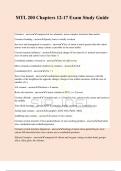
-
MTL 200 Chapters 12-17 Exam Study Guide
- Exam (elaborations) • 2 pages • 2024
-
- $10.49
- + learn more
MTL 200 Chapters 12-17 Exam Study Guide Ceramics - answercomposed of two elements, more complex structures than metals Ceramics bonding - answerpurely ionic to totally covalent Ion sizes and arrangment in ceramics - answersize of anion is much greater than the cation. anions want to touch as many cations as possible (to be most stable) Crystal structure influence - answerelectrical charge of ion (must be 0, neutral) and relative sizes of anion and cation (rc/ra is less than 1) Coordinate ...
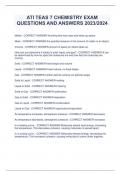
-
ATI TEAS 7 CHEMISTRY EXAM QUESTIONS AND ANSWERS 2023/2024
- Exam (elaborations) • 8 pages • 2023
- Available in package deal
-
- $14.99
- + learn more
ATI TEAS 7 CHEMISTRY EXAM QUESTIONS AND ANSWERS 2023/2024 Matter - CORRECT ANSWER-Anything that has mass and takes up space. Mass - CORRECT ANSWER-the quantity/measure of the amount of matter in an object. Volume - CORRECT ANSWER-amount of space an object takes up. How can you determine if matter is solid, liquid, and gas? - CORRECT ANSWER-It can be determined by how far apart the molecules are and how fast the molecules are moving. Solid - CORRECT ANSWER-fixed shape and volume Liqui...

-
BTEC Applied Science Unit One Chemistry – Complete Questions and Answers 2023
- Exam (elaborations) • 18 pages • 2023
-
- $10.49
- + learn more
BTEC Applied Science Unit One Chemistry – Complete Questions and Answers 2023. How many electrons can each orbital hold? correct answerTwo How many electrons can be held in each sub shell? correct answerS - 2 P - 6 D - 10 F - 18 Put the sub shells in order do their energy, lowest to highest correct answerS, p, d and f How do we fill the p and d subshells correct answersingly first and then doubly What is an orbital? correct answerA region of space around the nucleus where there is a 95%...
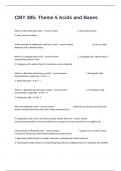
-
CMY 385: Theme 5 Acids and Bases Comprehensive Actual Exam Questions And Answers.
- Exam (elaborations) • 7 pages • 2024
-
Available in package deal
-
- $12.99
- + learn more
What is a Bronsted acid? base? - correct answer 1. Acid: proton donor 2. base: proton acceptor. Water example of amphiprotic substance, why? - correct answer can act as either Brønsted acid or Brønsted base What is a conjugate base/ acid? - correct answer 1. Conjugate base: species that is formed when proton is lost 2. Conjugate acid: species that is formed when proton is gai...
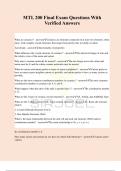
-
MTL 200 Final Exam Questions With Verified Answers
- Exam (elaborations) • 10 pages • 2024
-
- $12.49
- + learn more
MTL 200 Final Exam Questions With Verified Answers What are ceramics? - answerCeramics are elements composed of at least two elements, often more, with complex crystal structures that range from purely ionic to totally covalent. Anisotropy - answerdirectionality of properties What influences the crystal structure of ceramics? - answerThe electrical charge of ions and the relative sizes of the anion and cation. Why must a ceramic molecule be neutral? - answerThe net charge across the catio...
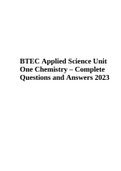
-
BTEC Applied Science Unit One Chemistry – Complete Questions and Answers 2023
- Exam (elaborations) • 18 pages • 2023
-
- $10.49
- + learn more
BTEC Applied Science Unit One Chemistry – Complete Questions and Answers 2023. How many electrons can each orbital hold? correct answerTwo How many electrons can be held in each sub shell? correct answerS - 2 P - 6 D - 10 F - 18 Put the sub shells in order do their energy, lowest to highest correct answerS, p, d and f How do we fill the p and d subshells correct answersingly first and then doubly What is an orbital? correct answerA region of space around the nucleus where there is a 95%...

-
Solutions Manual For Inorganic Chemistry, 6th Edition (Alen Hadzovic, 2024) Chapters 1-27, Latest Guide A+.
- Exam (elaborations) • 230 pages • 2024
-
- $24.99
- + learn more
Solutions Manual For Inorganic Chemistry, 6th Edition (Alen Hadzovic, 2024) Chapters 1-27, Latest Guide A+. TABLE OF CONTENTS Preface, v Acknowledgments, vii PART 1 Foundations Chapter 1 Atomic Structure Chapter 2 Molecular Structure and Bonding Chapter 3 The Structures of Simple Solids Chapter 4 Acids and Bases Chapter 5 Oxidation and Reduction Chapter 6 Molecular Symmetry Chapter 7 An Introduction to Coordination Compounds Chapter 8 Physical Techniques in Inorganic Chemistry PART ...
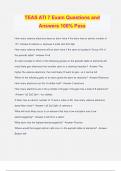
-
TEAS ATI 7 Exam Questions and Answers 100% Pass
- Exam (elaborations) • 18 pages • 2024
-
- $12.49
- + learn more
TEAS ATI 7 Exam Questions and Answers 100% Pass How many valence electrons does an atom have if the atom has an atomic number of 10? -Answer-8 valence e- because it ends with 2s2 2p6 How many valence electrons will an atom have if the atom is located in Group VIA of the periodic table? -Answer-VI=6 An atom located in which of the following groups on the periodic table of elements will most likely gain electrons from another atom in a chemical reaction? -Answer-The higher the valence elec...
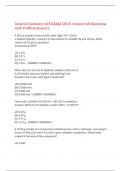
-
General Chemistry ACS EXAM (2015 version) 60 Questions with Verified Answers,100% CORRECT
- Exam (elaborations) • 16 pages • 2024
-
- $10.99
- + learn more
General Chemistry ACS EXAM (2015 version) 60 Questions with Verified Answers A 20.0 g sample of mercury(II) oxide (HgO, M = 216.6) is heated strongly, causing it to decompose to metallic Hg and O2 gas. What volume of O2 gas is produced (measured at STP)? (A) 1.03 L (B) 2.07 L (C) 4.14 L (D) 14.0 L - CORRECT ANSWER A When 30.0 mL of 0.10 M AgNO3 is added to 30.0 mL of 0.10 M NaCl, aqueous NaNO3 and solid AgCl are formed. How much solid AgCl is produced? (A) 0.0030 mol (B) 0.0...
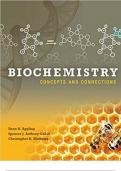
-
Test Bank for Biochemistry Concepts and Connections 1st Edition by Dean R. Appling, Spencer J. Anthony-Cahill & Christopher K. Mathews , ISBN: 9780321839923 |COMPLETE TEST BANK| Guide A+
- Exam (elaborations) • 102 pages • 2024
-
- $10.99
- + learn more
Biochemistry: Concepts and Connections (Appling et al.) Chapter 1 Biochemistry and the Language of Chemistry 1) The water content in the human body is approximately: A) 90%. B) 80%. C) 70%. D) 60%. E) 50%. Answer: C 2) The four most abundant chemical elements in living systems are: A) hydrogen, oxygen, sulfur and phosphorus. B) hydrogen, carbon, nitrogen and oxygen. C) sodium, potassium, carbon and oxygen. D) sodium, potassium, nitrogen and sulfur. E) carbon, nitrogen, oxygen and potassium. Answ...

How much did you already spend on Stuvia? Imagine there are plenty more of you out there paying for study notes, but this time YOU are the seller. Ka-ching! Discover all about earning on Stuvia


